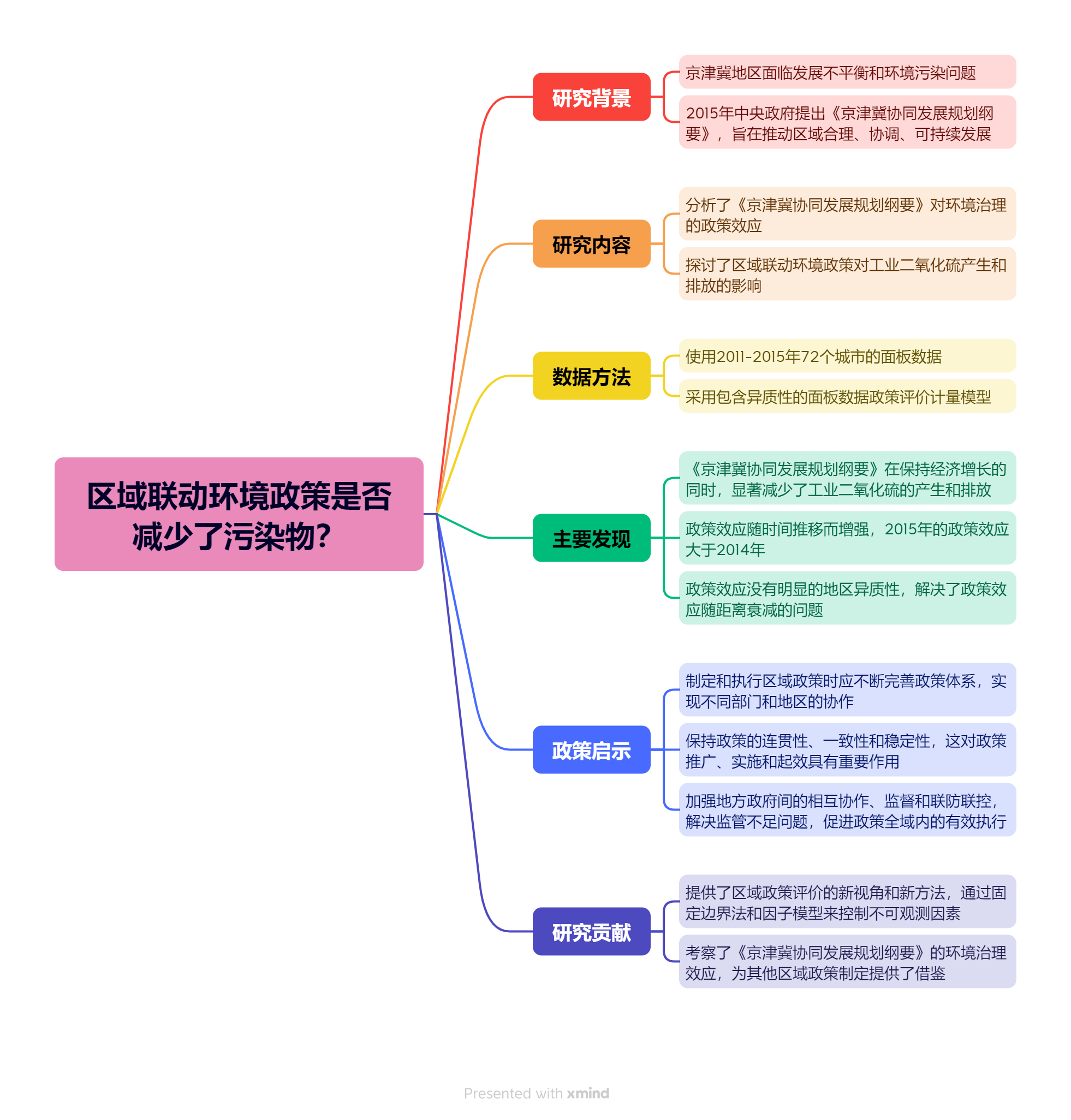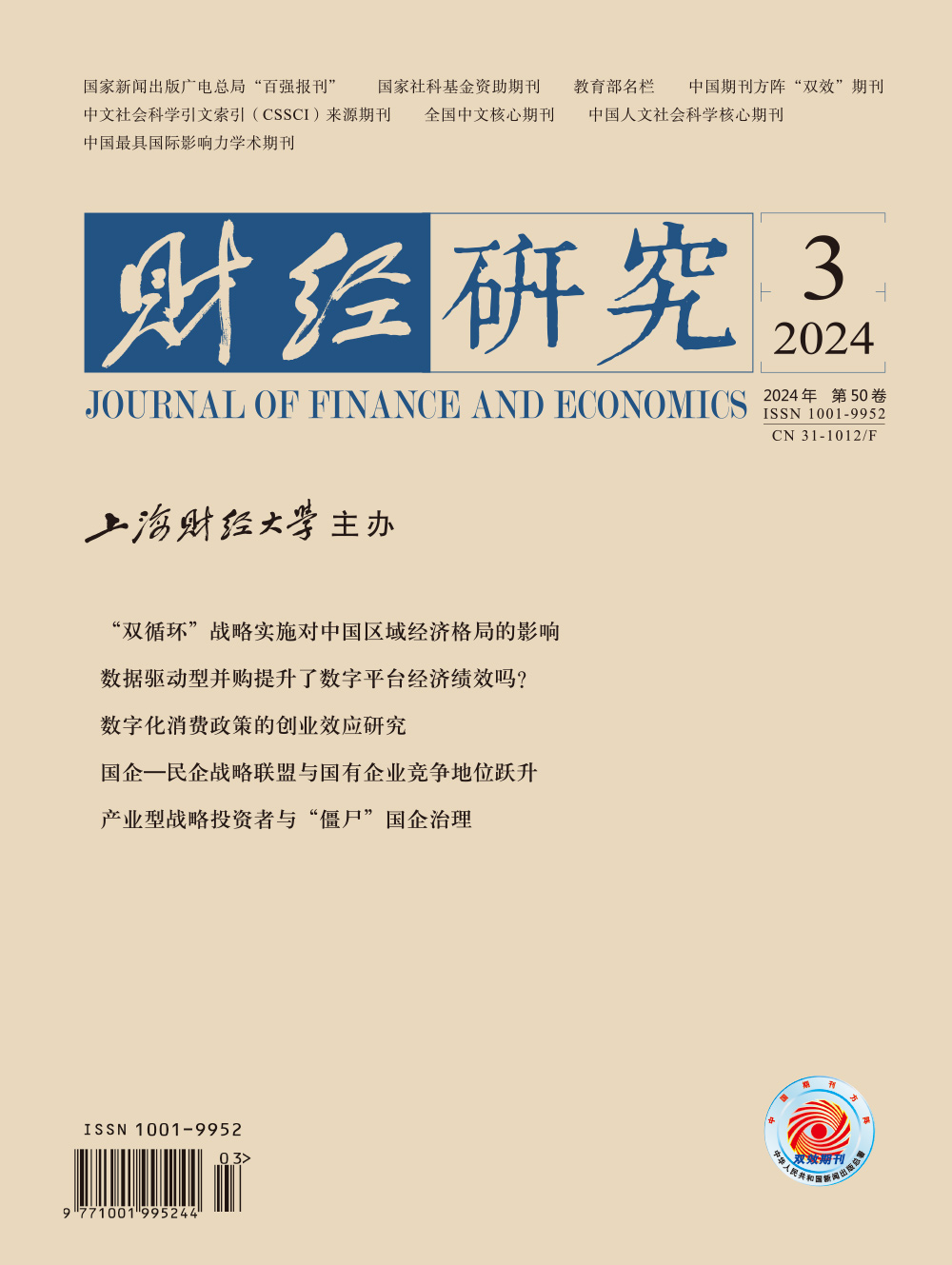随着《京津冀协同发展规划纲要》的出台,京津冀地区进入一个新的发展时期。这项重大国家战略对京津冀地区的产业发展、环境治理、市场一体化等方面具有重要影响。文章在理论分析的基础上,使用包含异质性的面板数据政策评价计量模型,从污染物产生和排放的视角,讨论了《京津冀协同发展规划纲要》对京津冀地区环境治理的政策效应。研究发现,《京津冀协同发展规划纲要》在保持经济增长的前提下,在环境治理方面呈现出显著的政策效应。在政策实施后第二年,工业二氧化硫的产生总量和排放总量分别减少了25%和14%,单位产生量和单位排放量分别减少了25%和15%。此外,政策效应随距离衰减的问题得到较好解决,不存在明显的区域异质性。文章还进行了模型的交叉验证和稳健性检验,证实了研究结果的可靠性。文章的研究为优化完善区域政策、更好推动区域协调发展提供了借鉴。
区域联动环境政策是否减少了污染物?——基于《京津冀协同发展规划纲要》环境治理的政策评价
摘要
参考文献
相关附件
思维导图
2 陈硕,陈婷. 空气质量与公共健康:以火电厂二氧化硫排放为例[J]. 经济研究,2014,(8):158−169. DOI:10.3969/j.issn.1672-5719.2014.08.119
3 崔亚飞,刘小川. 中国省级税收竞争与环境污染——基于1998−2006年面板数据的分析[J]. 财经研究,2010,(4):46−55. DOI:10.16538/j.cnki.jfe.2010.04.007
4 董香书,肖翔. “振兴东北老工业基地”有利于产值还是利润?——来自中国工业企业数据的证据[J]. 管理世界,2017,(7):24−34. DOI:10.3969/j.issn.1002-5502.2017.07.003
10 庞瑞芝,王亮. 服务业发展是绿色的吗?——基于服务业环境全要素效率分析[J]. 产业经济研究,2016,(4):18−28.
21 张亚雄,赵坤. 北京奥运会投资对中国经济的拉动影响——基于区域间投入产出模型的分析[J]. 经济研究,2008,(3):4−15.
25 Abadie A,Diamond A,Hainmueller J. Synthetic control methods for comparative case studies:Estimating the effect of California’s tobacco control program[J]. Journal of the American statistical Association,2010,105(490):493−505. DOI:10.1198/jasa.2009.ap08746
26 Bai C E,Li Q,Ouyang M. Property taxes and home prices:A tale of two cities[J]. Journal of Econometrics,2014,180(1):1−15. DOI:10.1016/j.jeconom.2013.08.039
27 Bai J S,Ng S. Determining the number of factors in approximate factor models[J]. Econometrica,2002,70(1):191−221. DOI:10.1111/1468-0262.00273
28 Bai J S. Panel data models with interactive fixed effects[J]. Econometrica,2009,77(4):1229−1279. DOI:10.3982/ECTA6135
29 Banzhaf H S,Chupp B A. Fiscal federalism and interjurisdictional externalities:New results and an application to US air pollution[J]. Journal of Public Economics,2012,96(5−6):449−464. DOI:10.1016/j.jpubeco.2012.01.001
30 Black S E. Do better schools matter? Parental valuation of elementary education[J]. The Quarterly Journal of Economics,1999,114(2):577−599. DOI:10.1162/003355399556070
31 Cai H B,Chen Y Y,Gong Q. Polluting thy neighbor:Unintended consequences of China’s pollution reduction mandates[J]. Journal of Environmental Economics and Management,2016,76:86−104. DOI:10.1016/j.jeem.2015.01.002
32 Campos N F,Kinoshita Y. Structural reforms,financial liberalization,and foreign direct investment[J]. IMF Staff Papers,2010,57(2):326−365. DOI:10.1057/imfsp.2009.17
33 Heckman J J,Hotz V J. Choosing among alternative nonexperimental methods for estimating the impact of social programs:The case of manpower training[J]. Journal of the American statistical Association,1989,84(408):862−874. DOI:10.1080/01621459.1989.10478848
34 Hodan W M,Barnard W R. Evaluating the contribution of PM2.5 precursor gases and re-entrained road emissions to mobile source PM2.5 particulate matter emissions[R]. MACTEC Federal Programs,2004.
35 Holdren J P,Ehrlich P R. Human population and the global environment[J]. American Scientist,1974,62(3):282−292.
36 Hsiao C,Steve Ching H,Ki Wan S. A panel data approach for program evaluation:Measuring the benefits of political and economic integration of Hong Kong with mainland China[J]. Journal of Applied Econometrics,2012,27(5):705−740. DOI:10.1002/jae.1230
37 Li H B,Zhou L A. Political turnover and economic performance:The incentive role of personnel control in China[J]. Journal of Public Economics,2005,89(9-10):1743−1762. DOI:10.1016/j.jpubeco.2004.06.009
38 Oates W E. Fiscal federalism[M]. New York:Harcourt,1972.
39 Oster E. Unobservable selection and coefficient stability:Theory and evidence[J]. Journal of Business & Economic Statistics,2019,37(2):187−204.
40 Panayotou T. Demystifying the environmental Kuznets curve:Turning a black box into a policy tool[J]. Environment and Development Economics,1997,2(4):465−484. DOI:10.1017/S1355770X97000259
41 Sigman H. International spillovers and water quality in rivers:Do countries free ride?[J]. American Economic Review,2002,92(4):1152−1159. DOI:10.1257/00028280260344687
42 Wang A L. The search for sustainable legitimacy:Environmental law and bureaucracy in China[J]. Harvard Environmental Law Review,2013,37:365.
43 Wang H,Wheeler D. Financial incentives and endogenous enforcement in China’s pollution levy system[J]. Journal of Environmental Economics and Management,2005,49(1):174−196. DOI:10.1016/j.jeem.2004.02.004
44 Wang S X,Xing J,Zhao B,et al. Effectiveness of national air pollution control policies on the air quality in metropolitan areas of China[J]. Journal of Environmental Sciences,2014,26(1):13−22. DOI:10.1016/S1001-0742(13)60381-2
45 Wu J,Deng Y H,Huang J,et al. Incentives and outcomes:China’s environmental policy[R]. Cambridge:National Bureau of Economic Research,2013.
46 Zheng S Q,Kahn M E,Sun W Z,et al. Incentives for China’s urban mayors to mitigate pollution externalities:The role of the central government and public environmentalism[J]. Regional Science and Urban Economics,2014,47:61−71. DOI:10.1016/j.regsciurbeco.2013.09.003
引用本文
忻恺, 张瑞涵, 朱震宇, 等. 区域联动环境政策是否减少了污染物?——基于《京津冀协同发展规划纲要》环境治理的政策评价[J]. 财经研究, 2024, 50(3): 19-32.
导出参考文献,格式为:





 2056
2056  2781
2781


